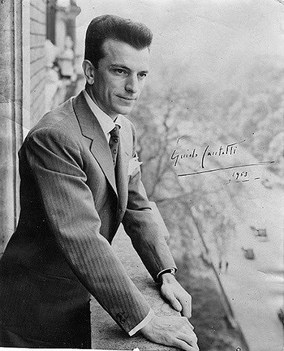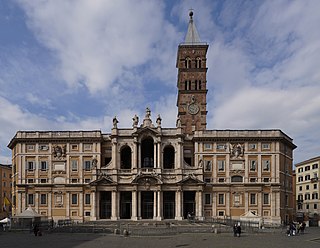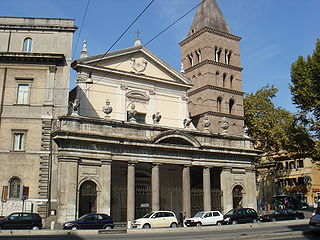
Viterbo is a city and comune (municipality) in the Lazio region of Italy, the capital of the province of Viterbo.

Guido Cantelli was an Italian orchestral conductor. Toscanini elected him his "spiritual heir" since the beginnings of his career. He was named Music Director of La Scala, Milan in November 1956, but his promising career was cut short only one week later by his death at the age of 36 in the 1956 Paris DC-6 crash in France en route to the United States.

The Basilica of Saint Mary Major, or church of Santa Maria Maggiore, is one of the four major papal basilicas as well as one of the Seven Pilgrim Churches of Rome and the largest Marian church in Rome, Italy. Santa Maria Maggiore is the first Marian sanctuary in the Western world and the mother of all sanctuaries.

Antonio da Sangallo the Younger, also known as Antonio Cordiani, was an Italian architect active during the Renaissance, mainly in Rome and the Papal States. One of his most popular projects that he worked on designing is St. Peter’s basilica in the Vatican City. He was also an engineer who worked on restoring several buildings. His success was greatly due to his contracts with renowned artists during his time. Sangallo died in Terni, Italy, and was buried in St. Peter’s Basilica.

The Basilica of St. Mary of the Angels and of the Martyrs is a Catholic titular minor basilica and former Carthusian conventual church in Rome, Italy, constructed in the ruined frigidarium and tepidarium of the Roman Baths of Diocletian in the Piazza della Repubblica.

The Minor Basilica of St. Lawrence in Damaso or simply San Lorenzo in Damaso is a parish and titular church in central Rome, Italy that is dedicated to St. Lawrence, deacon and martyr. It is incorporated into the Palazzo della Cancelleria, which enjoys the extraterritoriality of the Holy See.

Novara is the capital city of the province of Novara in the Piedmont region in northwest Italy, to the west of Milan. With 101,916 inhabitants, it is the second most populous city in Piedmont after Turin. It is an important crossroads for commercial traffic along the routes from Milan to Turin and from Genoa to Switzerland. Novara lies between the streams Agogna and Terdoppio in northeastern Piedmont, 50 km (31 mi) from Milan and 95 km (59 mi) from Turin. It is only 15 km (9.3 mi) distant from the river Ticino, which marks the border with Lombardy region.
This is a list of music conservatories in Naples, Italy.

San Crisogono is a church in Rome dedicated to the martyr Saint Chrysogonus. It was one of the tituli, the first parish churches of Rome, and was probably built in the 4th century under Pope Sylvester I (314–335).

The Diocese of Novara is a Latin Church diocese of the Catholic Church in the Piedmont region of northwest Italy. It is a suffragan of the Archdiocese of Vercelli.

The Archdiocese of Urbino–Urbania–Sant'Angelo in Vado is a Latin Church ecclesiastical territory or archdiocese of the Catholic Church in the Province of Pesaro and Urbino in the Marche region of central Italy. The current archbishop is Sandro Salvucci, appointed in January 2023. It was previously a metropolitan see.

The Conservatorio di Musica Benedetto Marcello di Venezia, also known as the Venice Conservatory, is a conservatory in Venice, Italy, named after composer Benedetto Marcello and established in 1876.

Santa Maria delle Vigne is a Roman Catholic basilica church in Genoa, Italy. It was built in the 10th century. The main altar was completed in 1730 by Giacomo Antonio Ponsonelli. The church is also the final resting place of the leading early Italian composer Alessandro Stradella, who was murdered in 1682.

The basilica of Santi Cosma e Damiano is a titular church in Rome, Italy. It is the conventual church of the General Curia of the Franciscan Third Order Regular. The lower portion of the building is accessible through the Roman Forum and incorporates original Roman buildings, but the entrance to the upper level is outside the Forum facing the Via dei Fori Imperiali.
The following is a timeline of the history of the city of Novara in the Piedmont region of Italy.

June 6th 2013 is a live album by American jazz trumpeter Wadada Leo Smith recorded with one of the foremost Italian avant-jazz group Eco D'Alberi.

The Fontana or Fontanone di Ponte Sisto, once known as the Fontanone dei Cento Preti, is an early 17th-century, monumental fountain now located in Piazza Trilussa, facing the south end of the Ponte Sisto, in Trastevere, Rome, Italy. It was reconstructed here in the late 19th century, originally erected across the river, attached to the former building of the Collegio Ecclesiastico.

Teatro Coccia is the main opera house in Novara, and is also the most important "historical" theatres in Piedmont. It faces along via Fratelli Rosselli, and delimits piazza dei Martiri to the west and piazza Giacomo Puccini to the east.
The Cantelli Award recognizes excellence in conducting. The prize was first awarded on October 3, 1961. The awards were hosted at the Teatro Coccia, in Novara, where also all the other editions were hosted. The prestigious prize was won, among others, by Ádám Fischer, Lothar Zagrosek, and Riccardo Muti, who was the first Italian to win the prize. Many winners of the prize went on to become prominent conductors.
















